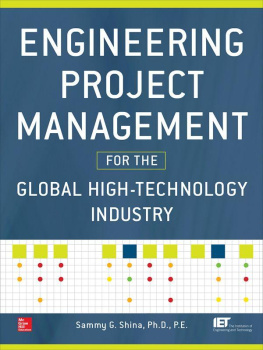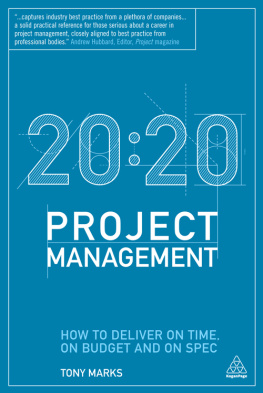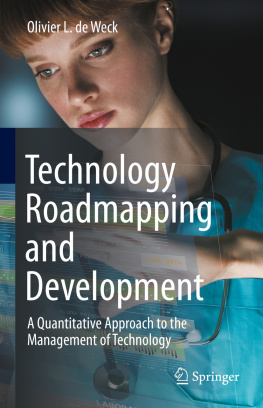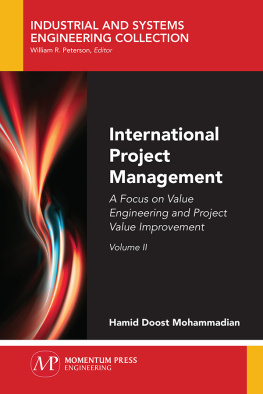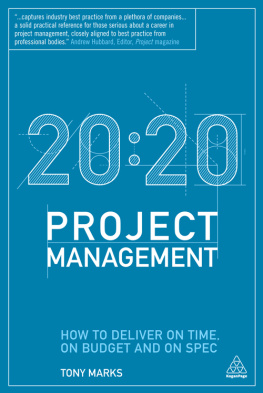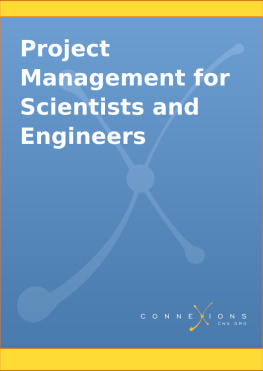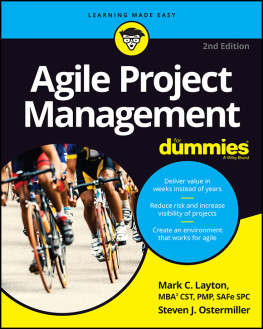Engineering Project Management for the Global High-Technology Industry
About the Author
Sammy G. Shina, Ph.D., P.E., is a professor of mechanical engineering at the University of Massachusetts Lowell (UML), and has lectured in the University of Pennsylvanias ExMSE Program and at the University of California Irvine. He is the coordinator of the Design and Manufacturing Certificate, the Quality Engineering Certificate, mechanical engineering senior capstone projects, and co-op education for the College of Engineering at UML. He is the founder of the New England Lead-Free Electronics Consortium, which researches, tests, and evaluates materials and processes for lead-free and RoHS compliance and conversion to nano-technology.
Dr. Shina is an international consultant, trainer, and seminar provider on project management, quality methods in design and manufacturing, Six Sigma, and design of experiments (DoE), as well as technology supply chains, product design and development, and electronics manufacturing, testing, and automation. He worked for 22 years in high-technology companies developing new products and state-of-the-art manufacturing technologies. Dr. Shina received B.S. degrees in electrical engineering and industrial management from Massachusetts Institute of Technology, an M.S. degree in computer science from Worcester Polytechnic Institute, and a Ph.D. degree in mechanical engineering from Tufts University. He is the author of several best-selling books on concurrent engineering, Six Sigma, green design, and engineering project management, and more than 100 papers.
Engineering Project Management for the Global High-Technology Industry
Sammy G. Shina, Ph.D., P.E.

New York Chicago San Francisco
Athens London Madrid
Mexico City Milan New Delhi
Singapore Sydney Toronto
Copyright 2014 by McGraw-Hill Education. All rights reserved. Except as permitted under the United States Copyright Act of 1976, no part of this publication may be reproduced or distributed in any form or by any means, or stored in a database or retrieval system, without the prior written permission of the publisher.
ISBN: 978-0-07-181537-6
MHID: 0-07-181537-6
e-Book conversion by Cenveo Publisher Services
Version 1.0
The material in this eBook also appears in the print version of this title: ISBN: 978-0-07-181536-9, MHID: 0-07-181536-8.
McGraw-Hill Education eBooks are available at special quantity discounts to use as premiums and sales promotions, or for use in corporate training programs. To contact a representative, please visit the Contact Us page at www.mhprofessional.com.
All trademarks are trademarks of their respective owners. Rather than put a trademark symbol after every occurrence of a trademarked name, we use names in an editorial fashion only, and to the benefit of the trademark owner, with no intention of infringement of the trademark. Where such designations appear in this book, they have been printed with initial caps.
Information has been obtained by McGraw-Hill Education from sources believed to be reliable. However, because of the possibility of human or mechanical error by our sources, McGraw-Hill Education, or others, McGraw-Hill Education does not guarantee the accuracy, adequacy, or completeness of any information and is not responsible for any errors or omissions or the results obtained from the use of such information.
TERMS OF USE
This is a copyrighted work and McGraw-Hill Education and its licensors reserve all rights in and to the work. Use of this work is subject to these terms. Except as permitted under the Copyright Act of 1976 and the right to store and retrieve one copy of the work, you may not decompile, disassemble, reverse engineer, reproduce, modify, create derivative works based upon, transmit, distribute, disseminate, sell, publish or sublicense the work or any part of it without McGraw-Hill Educations prior consent. You may use the work for your own noncommercial and personal use; any other use of the work is strictly prohibited. Your right to use the work may be terminated if you fail to comply with these terms.
THE WORK IS PROVIDED AS IS. McGRAW-HILL EDUCATION AND ITS LICENSORS MAKE NO GUARANTEES OR WARRANTIES AS TO THE ACCURACY, ADEQUACY OR COMPLETENESS OF OR RESULTS TO BE OBTAINED FROM USING THE WORK, INCLUDING ANY INFORMATION THAT CAN BE ACCESSED THROUGH THE WORK VIA HYPERLINK OR OTHERWISE, AND EXPRESSLY DISCLAIM ANY WARRANTY, EXPRESS OR IMPLIED, INCLUDING BUT NOT LIMITED TO IMPLIED WARRANTIES OF MERCHANTABILITY OR FITNESS FOR A PARTICULAR PURPOSE. McGraw-Hill Education and its licensors do not warrant or guarantee that the functions contained in the work will meet your requirements or that its operation will be uninterrupted or error free. Neither McGraw-Hill Education nor its licensors shall be liable to you or anyone else for any inaccuracy, error or omission, regardless of cause, in the work or for any damages resulting therefrom. McGraw-Hill Education has no responsibility for the content of any information accessed through the work. Under no circumstances shall McGraw-Hill Education and/or its licensors be liable for any indirect, incidental, special, punitive, consequential or similar damages that result from the use of or inability to use the work, even if any of them has been advised of the possibility of such damages. This limitation of liability shall apply to any claim or cause whatsoever whether such claim or cause arises in contract, tort or otherwise.
To my wife Jackie,
and our children and grandchildren.

Contents

Preface
E ngineering project management is becoming more important as technology companies compete in a worldwide market for customers desiring high-quality and low-cost products. The project manager (PM) has to be a jack of all trades, a product champion, a great organizer, a leader, mentor, and motivator of the team; the PM has to be an effective communicator, a salesperson, a financial analyst, and much more. The PM today must be an expert in technology, quality, cost, teamwork, supply chains, and market dynamics. The PM must always balance priorities and make good decisions regarding resource allocation, schedule variability, cost, technology adoption, and risk management.
This book attempts to augment the basic project-management principles of scheduling, tracking, and control of projects with answering many of the questions posed by the role of technology in new product creation. Why do some companies thrive in the technology arena, while others start well but cannot maintain the momentum? Why is it so difficult for companies to enter some markets? What are the options available to companies for setting new product price and performance? What types of organizational structures and methods are needed to successfully manage technical projects? How can company resources and the supply chain be leveraged?
This book attempts to answer these questions by examining product lifecycles, project management types, and where they should be used as well as tools and techniques of quality cost and marketplace. Economic analysis of the project potential and how to best leverage internal resources versus supply chains, as well as risk and rewards of project decisions, are also examined. The book illustrates these principles with examples of current technology-company policies, some drawn from the headlines and some from my own experience. I have an extensive history of managing many development projects, consulting to technology companies, and researching the tools and techniques of new product creation. In addition, long conversations and meetings with many of the creators of project management tools, CEOs, and members of the boards of directors of companies, and several expert-witness litigation cases, have given me a unique perspective of the challenges and concerns of global technology companies.
Next page
